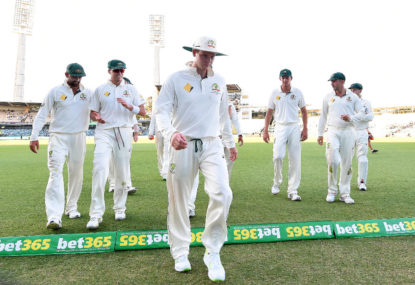Australia and India look set to fight out a classic series, after the home team ploughed back into the fray with a rousing win in the second Test at Bangalore.
Perhaps not since the 2005 Ashes have I seen an Australian Test match blessed with such bottomless drama.
Alongside umpiring blunders, poor shots, missed reviews, sledging wars, dropped catches and batting collapses, we witnessed scorching spells, gritty knocks, miraculous grabs and tactical brilliance.
As I wrote on Monday, the second day was the most intense day two of a Test I have ever watched. Yesterday, somehow, was even better.
Not until Australia’s seventh wicket fell, with dangerous hitter Mitchell Starc dismissed, did it become crystal clear who would win the match.
Until then it was a dipping, darting, deceiving devil of a day – you could never be sure what direction it would head next.
India started at 4-213, with a lead of 126. In the first ten overs two shots lobbed just short of fielders, Nathan Lyon secured an LBW only to have it overturned on review, and Mitchell Starc skimmed the off stump of Ajinyka Rahane.
Despite these near misses, by the time Cheteshwar Pujara and Ajinkya Rahane extended the lead to 151 with six wickets still in hand, the match seemed to be slipping from the Australians’ paws.
The second new ball arrived as Australia’s great hope. But it was wasted initially by Starc and Josh Hazlewood, who too rarely landed deliveries where they needed to – full and straight.
With the pitch seeming to have calmed down and Pujara and Rahane well set, India were poised to bat Australia out of the match. But, being the unpredictable beast that he is, Starc then flipped the script on its noggin.
Cranking his speed up to 152kmh, Starc snared Rahane and Karun Nair in consecutive balls, before almost completing his hat trick. This sparked Hazlewood, who then grabbed three wickets in the space of nine balls.
India lost 6-36 and suddenly the Test was once again a 50-50 proposition, with Australia needing 188 to win. The tourists had batted with uncommon caution across their first three innings in this series. This time they emerged with a more assertive mindset.
They weren’t playing with undue risk, rather Australia were patently trying to turn some pressure back on the Indian bowlers. By the end of the ninth over Australia were humming along at 1-42, with Renshaw gone after nicking a wonderful rearing delivery from Indian seamer Ishant Sharma, who bowled superbly once again.
Then the first delivery of the tenth over set in motion a chain of events which saw Australia crumble. Warner tried to sweep a full delivery from Indian off spinner Ravi Ashwin, was struck on the pad and given out LBW.

Replays showed the ball pitching about 10cm outside off stump and then straightening ever so slightly and seemingly hitting Warner outside the line of off stump. The decision looked certain to be overturned.
But HawkEye found that a miniscule amount of the ball was in fact in line with the stumps and the ball was carrying on to shave off stump so Warner had to go. It was a tough decision for Australia, although no more so than the marginal LBW call received by Indian captain Virat Kohli the previous day.
The difference was that Warner’s unlucky dismissal effectively cost Australia two wickets. Five overs later, Australia were in good shape at 2-67, with skipper Steve Smith and first innings topscorer Shaun Marsh both looking comfortable.
A wonderful piece of reverse swing bowling from Indian quick Umesh Yadav, who was equally as impressive as Ishant, tricked Marsh into shouldering arms. The umpire fired Marsh LBW in what immediately appeared to be a bad decision.
HawkEye confirmed what a shocking call it was, with the ball missing off stump by the best part of 10cm. In almost any other circumstance Marsh would have immediately reviewed the decision.
With the immense pressure of this incredible Test weighing on him, and Warner’s burned review fresh in his memory, he instead sought the advice of Smith.
The Aussie captain was in a poor position to provide him advice – Yadav was bowling around the wicket to the left-hander, creating an angle that made it difficult for Smith to accurately predict the path of the ball.
So Smith shrugged and Marsh walked off. It was the moment that cost Australia the match.
That’s not to suggest that poor umpiring was to blame for Australia’s loss. The tourists were beaten by a quality team who, until last week in Pune, had not lost a Test at home since 2012.
Australia may have controlled the first one-and-half Tests of this series, but now they face the enormous challenge of reeling in an Indian side which has built up momentum.
Here’s hoping Australia can retain their fierce determination and push this series all the way to the last day of the fourth Test. What a treat that would be for cricket fans.






























































































